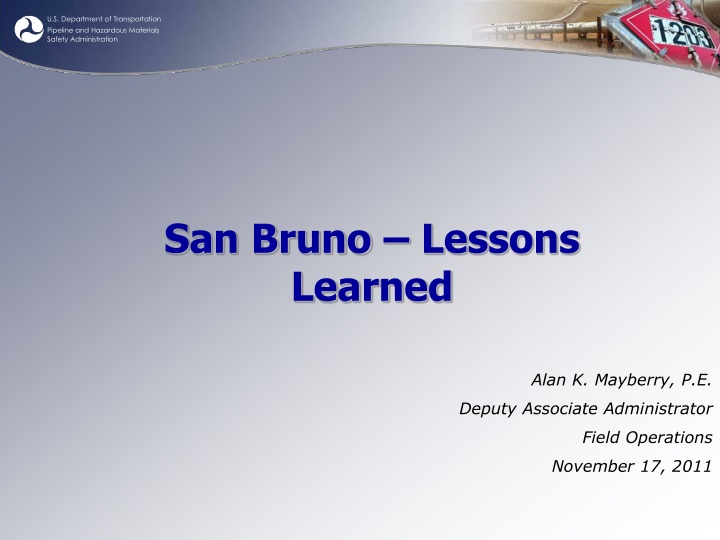
Lessons Learned from U.S. Department of Transportation Pipeline Safety Administration
Gain insights into the U.S. Department of Transportation Pipeline and Hazardous Materials Safety Administration's efforts in ensuring safe, reliable, and environmentally sound operations of the nation's pipeline transportation system. Discover the common goals, recent events highlighting weaknesses in risk management, challenges in risk analysis, and a review of the PHMSA's oversight program.
Download Presentation

Please find below an Image/Link to download the presentation.
The content on the website is provided AS IS for your information and personal use only. It may not be sold, licensed, or shared on other websites without obtaining consent from the author. If you encounter any issues during the download, it is possible that the publisher has removed the file from their server.
You are allowed to download the files provided on this website for personal or commercial use, subject to the condition that they are used lawfully. All files are the property of their respective owners.
The content on the website is provided AS IS for your information and personal use only. It may not be sold, licensed, or shared on other websites without obtaining consent from the author.
E N D
Presentation Transcript
U.S. Department of Transportation Pipeline and Hazardous Materials Safety Administration San Bruno Lessons Learned Alan K. Mayberry, P.E. Deputy Associate Administrator Field Operations November 17, 2011
U.S. Department of Transportation Pipeline and Hazardous Materials Safety Administration PHMSA Mission To ensure the safe, reliable, and environmentally sound operation of the Nation s pipeline transportation system.
U.S. Department of Transportation Pipeline and Hazardous Materials Safety Administration Goals and Pathways Common Goals Safe, Clean, and Reliable Energy Pipelines Different Responsibilities Industry Regulators Congress Public We all need to re-examine our assumptions, our strategies, and improve (not just defend) our performance
U.S. Department of Transportation Pipeline and Hazardous Materials Safety Administration Recent Events Illustrate Weaknesses in Managing Risk Effective risk analysis might have prevented or mitigated recent high consequence accidents Weaknesses include inadequate: Knowledge of pipeline risk characteristics including recordkeeping Processes to analyze interactive threats Evaluation of ways to reduce or mitigate consequences Process to select P&M measures Lack of objective, systematic approach - 4 -
U.S. Department of Transportation Pipeline and Hazardous Materials Safety Administration Inspections Identify Weaknesses in Risk Analysis Current challenge is for industry to develop More rigorous quantitative risk analyses More investigative approach Engineering critical assessment Robust approach for P&M measures Technically sound risk-based criteria Including pipe replacement - 5 -
U.S. Department of Transportation Pipeline and Hazardous Materials Safety Administration Review of PHMSA s Oversight Program National Transportation Safety Board Government Accountability Office Inspector General Congress - 6 -
U.S. Department of Transportation Pipeline and Hazardous Materials Safety Administration Cabinet Level Engagement Secretary LaHood s Call to Action Pipeline Safety Forum Pipeline Safety Action Plan Report to America - 7 -
U.S. Department of Transportation Pipeline and Hazardous Materials Safety Administration DOT Pipeline Safety Action Plan Near Term (3 months) Getting Reauthorization Done (maybe, just maybe) National Infrastructure Bank Proposal for Distribution Pipes Report to America Workshop June 15 (D.C.) State Survey of Innovative Rate Recovery Legislation Outreach to ALL Critical Players Including NARUC/FERC International Regulators Conference July 18-19 Pipe Seam Workshop July 20 (report later) Risk Assessment/Records Workshop July 21 (webcast) Research and Development: Meeting of Principals
U.S. Department of Transportation Pipeline and Hazardous Materials Safety Administration DOT Pipeline Safety Action Plan Mid Term (6 months) Publication of Pipeline Safety: Report To The Nation Expanded State Enforcement Training Promoting greater State use of ALL authorities, as well as making State authorities substantially the same as OPS enforcement authority Begin Oversight of DIMP and CRM with States - NOW Public Safety/First Responder Forum 12/9/2011 3rd Party Excavation Damage Enforcement NPRM 12/11
U.S. Department of Transportation Pipeline and Hazardous Materials Safety Administration DOT Pipeline Safety Action Plan Long Term (12 months) Technical Workshop regarding Leak Detection & Valves 1st Q CY 2012 Develop more aggressive/independent and better funded Pipeline Safety R&D Plan R&D Forum 1st / 2nd Q CY 2012 Evaluate Near Miss reporting system options Roll out Vehicular Damage Public Awareness Campaign Revise and execute MOU s with FERC, USCG, and EPA
U.S. Department of Transportation Pipeline and Hazardous Materials Safety Administration PHMSA Actions Inspection and Enforcement Program Notices to Industry and the Public Emergency Response Risk and Record Keeping Regulations Data and Statistics
U.S. Department of Transportation Pipeline and Hazardous Materials Safety Administration NTSB Recommendations on San Bruno 4 to US DOT 13 to PHMSA Initial response to recommendations in the next week Follow up actions in progress - 12 -
U.S. Department of Transportation Pipeline and Hazardous Materials Safety Administration Why do regulations take so long to change? Gas Pipeline Safety Regulations ANPRM - Part 192 (comments due Jan 20, 2012) IMP, P&M Measures, Repair Criteria, Risk Analysis, Gathering lines PHMSA-2011-0023 Liquid Pipeline Safety Regulations NPRM - Part 195 (under development) IMP, Repair Criteria, SCC, EFRDs, Leak Detection PHMSA-2010-0229 http://www.regulations.gov
U.S. Department of Transportation Pipeline and Hazardous Materials Safety Administration Questions - 14 -
U.S. Department of Transportation Pipeline and Hazardous Materials Safety Administration PHMSA Actions Inspection and Enforcement Program Integrity Management Protocols Pipeline Risk Ranking Methodology Inspection migration from prescriptive to risk based (integrated approach) Public Awareness Effectiveness Inspections Control Room Management Inspections Anticipate new Congressional Mandates
